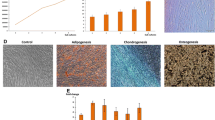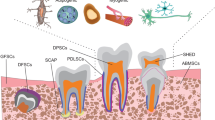Abstract
Cerebellar ataxias (CA) include a range of neurodegenerative disorders hallmarked by deterioration of the cerebellum. Cell replacement therapy (CRT) offers a potential remedy for the diseases associated with the central nervous system (CNS). This study was designed to assess the neurorestorative/protective effects of dental pulp stem cell (DPSC) implantation on a rat model of CA induced by 3-acetylpyridine (3-AP) as a neurotoxin. To begin, human DPSCs were extracted, cultured and phenotypically characterized. Then, experimental ataxia was induced in 20 male adult rats by a single injection of 3-AP and bilateral DPSC transplantation was performed 3 days after 3-AP administration, followed by stereological analysis of cerebellar layers along with assessment of motor skills and inflammatory response. The findings showed that transplantation of DPSCs in a 3-AP model of ataxia ameliorated motor coordination and muscle activity, increased cerebellar volumes of molecular and granular layers plus white matter, reduced the levels of inflammatory cytokines and thwarted the degeneration of Purkinje cells against 3-AP toxicity. Taken together, human DPSCs could be considered as a suitable candidate for CRT-based therapies with a specific focus on CA.





Similar content being viewed by others
References
Ahmadi H, Boroujeni ME, Sadeghi Y, Abdollahifar MA, Khodagholi F, Meftahi GH, Hadipour M, Bayat A-H, Shaerzadeh F, Aliaghaei A (2018) Sertoli cells avert neuroinflammation-induced cell death and improve motor function and striatal atrophy in rat model of Huntington disease. J Mol Neurosci 65:17–27
de Almeida FM, Marques SA, Ramalho Bdos S, Rodrigues RF, Cadilhe DV, Furtado D, Kerkis I, Pereira LV, Rehen SK, Martinez AM (2011) Human dental pulp cells: a new source of cell therapy in a mouse model of compressive spinal cord injury. J Neurotrauma 28:1939–1949
Arthur A, Rychkov G, Shi S, Koblar SA, Gronthos S (2008) Adult human dental pulp stem cells differentiate toward functionally active neurons under appropriate environmental cues. Stem Cells 26:1787–1795
Boroujeni ME, Gardaneh M (2017) Umbilical cord: an unlimited source of cells differentiable towards dopaminergic neurons. Neural Regen Res 12:1186–1192
Boroujeni ME, Gardaneh M (2018) The superiority of sucrose cushion centrifugation to ultrafiltration and PEGylation in generating high-titer lentivirus particles and transducing stem cells with enhanced efficiency. Mol Biotechnol 60:1–9
Boroujeni ME, Gardaneh M, Hassan Shahriari M, Aliaghaei A, Hasani S (2017) Synergy between choroid plexus epithelial cell-conditioned medium and knockout serum replacement converts human adipose-derived stem cells to dopamine-secreting neurons. Rejuvenation Res 20:309–319
Brusse E, Maat-Kievit J, Van Swieten J (2007) Diagnosis and management of early-and late-onset cerebellar ataxia. Clin Genet 71:12–24
Butterworth RF, Hamel E, Landreville F, Barbeau A (1978) Cerebellar ataxia produced by 3-acetyl pyridine in rat. Can J Neurol Sci 5(1):131–133
Calatrava-Ferreras L, Gonzalo-Gobernado R, Herranz AS, Reimers D, Montero Vega T, Jiménez-Escrig A, Richart López LA, Bazán E (2012) Effects of intravenous administration of human umbilical cord blood stemcells in 3-acetylpyridine-lesioned rats. Stem Cells Int 2012:135187. https://doi.org/10.1155/2012/135187
Da Cunha JM, da Costa-Neves A, Kerkis I, da Silva MCP (2013) Pluripotent stem cell transcription factors during human odontogenesis. Cell Tissue Res 353:435–441
Ebrahimi MJ, Aliaghaei A, Boroujeni ME, Khodagholi F, Meftahi G, Abdollahifar MA, Ahmadi H, Danyali S, Daftari M, Sadeghi Y (2018) Human umbilical cord matrix stem cells reverse oxidative stress-induced cell death and ameliorate motor function and striatal atrophy in rat model of Huntington disease. Neurotox Res 34(2):273–284. https://doi.org/10.1007/s12640-018-9884-4
Fernandez AM, De La Vega AG, Torres-Aleman I (1998) Insulin-like growth factor I restores motor coordination in a rat model of cerebellar ataxia. Proc Natl Acad Sci U S A 95(3):1253–1258
Govindasamy V, Abdullah AN, Ronald VS, Musa S, Ab Aziz ZA, Zain RB, Totey S, Bhonde RR, Abu Kasim NH (2010) Inherent differential propensity of dental pulp stem cells derived from human deciduous and permanent teeth. J Endod 36:1504–1515
Gronthos S, Brahim J, Li W, Fisher LW, Cherman N, Boyde A, DenBesten P, Robey PG, Shi S (2002) Stem cell properties of human dental pulp stem cells. J Dent Res 81:531–535
Heese K, Low JW, Inoue N (2006) Nerve growth factor, neural stem cells and Alzheimer’s disease. Neurosignals 15:1–12
Ibarretxe G, Crende O, Aurrekoetxea M, García-Murga V, Etxaniz J, Unda F (2012) Neural crest stem cells from dental tissues: a new hope for dental and neural regeneration. Stem Cells Int 2012:1–12
Janahmadi M, Goudarzi I, Kaffashian MR, Behzadi G, Fathollahi Y, Hajizadeh S (2009) Co-treatment with riluzole, a neuroprotective drug, ameliorates the 3-acetylpyridine-induced neurotoxicity in cerebellar Purkinje neurones of rats: behavioural and electrophysiological evidence. Neurotoxicology 30:393–402
Jiang YY, Cao BB, Wang XQ, Peng YP, Qiu YH (2015) Cerebellar ataxia induced by 3-AP affects immunological function. Neuro Endocrinol Lett 36(3):246–256
Kerkis I, Kerkis A, Dozortsev D, Stukart-Parsons GC, Massironi SMG, Pereira LV, Caplan AI, Cerruti HF (2006) Isolation and characterization of a population of immature dental pulp stem cells expressing OCT-4 and other embryonic stem cell markers. Cells Tissues Organs 184:105–116
Lindvall O, Kokaia Z (2004) Recovery and rehabilitation in stroke. Stem Cells 35:2691–2694
Marmolino D, Manto M (2010) Past, present and future therapeutics for cerebellar ataxias. Curr Neuropharmacol 8:41–61
Marsden J, Harris C (2011) Cerebellar ataxia: pathophysiology and rehabilitation. Clin Rehabil 25(3):195–216
Martens W, Bronckaers A, Politis C, Jacobs R, Lambrichts I (2013) Dental stem cells and their promising role in neural regeneration: an update. Clin Oral Investig 17:1969–1983
Mead B, Logan A, Berry M, Leadbeater W, Scheven BA (2014) Paracrine-mediated neuroprotection and neuritogenesis of axotomised retinal ganglion cells by human dental pulp stem cells: comparison with human bone marrow and adipose-derived mesenchymal stem cells. PLoS One 9:e109305
Miura M, Gronthos S, Zhao M, Lu B, Fisher LW, Robey PG, Shi S (2003) SHED: stem cells from human exfoliated deciduous teeth. Proc Natl Acad Sci U S A 100:5807–5812
Nosrat IV, Widenfalk J, Olson L, Nosrat CA (2001) Dental pulp cells produce neurotrophic factors, interact with trigeminal neurons in vitro, and rescue Motoneurons after spinal cord injury. Dev Biol 238:120–132
Sakai K, Yamamoto A, Matsubara K, Nakamura S, Naruse M, Yamagata M, Sakamoto K, Tauchi R, Wakao N, Imagama S, Hibi H, Kadomatsu K, Ishiguro N, Ueda M (2012) Human dental pulp-derived stem cells promote locomotor recovery after complete transection of the rat spinal cord by multiple neuro-regenerative mechanisms. J Clin Invest 122:80–90
Sierra A, Azcoitia Í, Garcia-Segura LM (2003) Endogenous estrogen formation is neuroprotective in model of cerebellar ataxia. Endocrine 21:43–51
Tatullo M, Marrelli M, Shakesheff KM, White LJ (2015) Dental pulp stem cells: function, isolation and applications in regenerative medicine. J Tissue Eng Regen Med 9:1205–1216
Wang S, Qu X, Zhao RC (2012) Clinical applications of mesenchymal stem cells. J Hematol Oncol 5(19)
Yamagata M, Yamamoto A, Kako E, Kaneko N, Matsubara K, Sakai K, Sawamoto K, Ueda M (2013) Human dental pulp-derived stem cells protect against hypoxic-ischemic brain injury in neonatal mice. Stroke 44:551–554
Yamamoto A, Sakai K, Matsubara K, Kano F, Ueda M (2014) Multifaceted neuro-regenerative activities of human dental pulp stem cells for functional recovery after spinal cord injury. Neurosci Res 78:16–20
Yasui T, Mabuchi Y, Toriumi H, Ebine T, Niibe K, Houlihan DD, Morikawa S, Onizawa K, Kawana H, Akazawa C, Suzuki N, Nakagawa T, Okano H, Matsuzaki Y (2016) Purified human dental pulp stem cells promote osteogenic regeneration. J Dent Res 95:206–214
Acknowledgments
This research project was performed at the Cell Biology & Anatomical Sciences Department, Shahid Beheshti University of Medical Sciences.
Funding
This research project was supported by the Vice Chancellor of Research of the Shahid Beheshti University of Medical Sciences.
Author information
Authors and Affiliations
Corresponding author
Ethics declarations
Conflict of interest
The authors declare that they have no conflict of interest.
Informed consent
Informed consent was obtained from all individual participants included in the study.
Ethical approval
All procedures performed in the present study involving humans and animals were in accordance with the ethical standards of the Ethical Committee of Shahid Beheshti University of Medical Sciences, Tehran, Iran.
Additional information
Publisher’s Note
Springer Nature remains neutral with regard to jurisdictional claims in published maps and institutional affiliations.
Electronic supplementary material
ESM 1
(DOCX 100 kb)
Rights and permissions
About this article
Cite this article
Aliaghaei, A., Boroujeni, M.E., Ahmadi, H. et al. Dental pulp stem cell transplantation ameliorates motor function and prevents cerebellar atrophy in rat model of cerebellar ataxia. Cell Tissue Res 376, 179–187 (2019). https://doi.org/10.1007/s00441-018-02980-x
Received:
Accepted:
Published:
Issue Date:
DOI: https://doi.org/10.1007/s00441-018-02980-x




